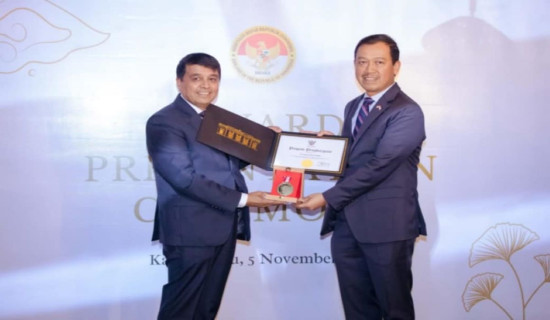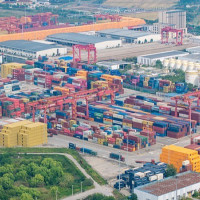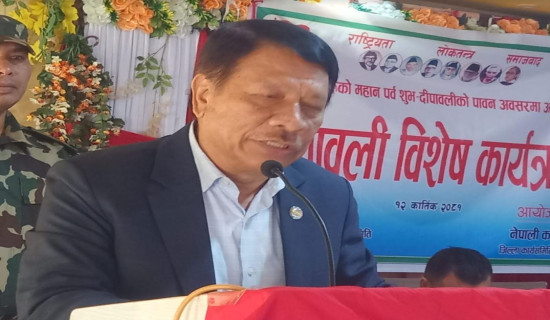- Wednesday, 6 November 2024
Paddy Day marked across country
By A Staff Reporter,Kathmandu, June 30: Asar 15 (June 29) is a significant day for the people coming together to honour and appreciate the hard work of farmers and the importance of agriculture in Nepal. Dhan Diwas or ‘Paddy Day’ is a special occasion that highlights the deep-rooted connection between farmers and the land, and vital food security.
On the occasion, farmers across the country celebrated the 21st National Paddy Day and Paddy Planting Festival 2024 on Saturday. The provincial governments and local levels organised the various programmes to celebrate the day by planting paddy and savouring Dahi Chiura.
According to the Department of Agriculture, paddy plantation has been going on across the country with the beginning of rainfall. Paddy plantation has been completed in around 10 per cent of the country’s total paddy field by June 27, 2024.
According to the Department, paddy has been planted in 25 per cent in Sudurpashchim Province, 23.9 per cent in Karnali Province, 18.3 per cent in Bagmati Province, 8.8 per cent in Lumbini Province and 8.3 per cent in Gandaki Province. Similarly, paddy plantation has been completed in 5.6 per cent in Koshi Province and 2.9 per cent in Madhes Province.
According to our Nepalgunj correspondent, the national paddy day has been marked in the district by planting paddy in different places of the districts. Minister for Agriculture and Land Management of the Lumbini Province government Bhandari Lal Ahir has said that the government would increase access to modern agricultural equipment and make proper arrangements for irrigation and fertiliser to increase agricultural production.
Speaking at the 21st National Paddy Day and Paddy Planting Festival organised at Nepalgunj-19 in Banke on Saturday, Minister Ahir said that the government would provide all kinds of support to the farmers to increase agricultural production. On the occasion, Minister of Economic Affairs of Lumbini Province Chet Narayan Acharya, Minister of Water Resources, Energy and Irrigation Krishna KC and Minister of Home Affairs Dinesh Panthi participated in the event stressed on the need of attracting youth to agriculture.
They said that it would not be possible to advance the economic development and to end unemployment until and unless youths were attracted to agriculture.
Similarly, the 21st National Paddy Day and Paddy Planting Festival was marked in various other places of the district as well, according to Agricultural Knowledge Centre, Banke. There is a total of 36,500 hectares of cultivable land where rice was planted.
Shakil Ahmed, chief of Agriculture Knowledge Centre, Banke, said that it was estimated that rice cultivation would be done in all the areas this year. The paddy plantation had been done in entire paddy field last year.
According to him, around 146,000 tonnes of paddy was produced in Banke last year at a rate of 4 tonnes per hectare. It is estimated that paddy would be produced in the same proportion this year.
15% paddy plantation completes in Gulmi
According to our Gulmi correspondent, around 15 per cent paddy plantation had been completed in Gulmi district so far. Nabaraj Bhandari, chief of Agriculture Knowledge Centre, said that due to lack of rain on time, paddy plantation had decreased in the district.
It is estimated that paddy would be planted in around 7,900 hectares of land in Gulmi this year. So far, irrigation facilities had reached an area of about 11,720 hectares in the district.
There are 85,670 hectares of cultivable land in the district. Out of this, 34,395 hectares of land is irrigable, according to the AKC. The cultivable land has become barren in recent times, said Bhandari.
He said that due to the migration of young people abroad, only the elderly living in the villages, and increasing migration, the land was becoming barren and paddy production reduced.
According to our Bhairahawa correspondent, paddy plantation has been completed in 25 per cent of the total paddy fields in Rupandehi by June 29, this year. The paddy planting has started in different places of Rupandehi after it rained a few days ago.
Shiva Prasad Aryal, chief of Agricultural Knowledge Centre, Rupandehi, said that according to the information received from various municipalities of the district, paddy plantation had been completed in 25 per cent of the fields so far. Of the total 85,000 hectares of arable land in Rupandehi, paddy is being planted in only 65 per cent of the fields.
Paddy, rice worth Rs. 21.13 billion imported in 11 months
Even though celebrating the 21st National Paddy Day, the country has been spending billions of rupees for the import of paddy and rice to meet the national demand. The country has imported paddy and rice worth Rs. 21.13 billion during the first 11 months of the current fiscal year.
During the review period, around 307,417 tonnes of paddy worth Rs. 12.43 billion and 82,791 tonnes of rice worth Rs. 8.7 billion have been imported. The import of rice and paddy has decreased by 37.16 per cent during the review period as compared to same period last fiscal year.
The country had imported paddy and rice worth Rs. 33.63 billion during the first 11 months of the current fiscal year. The country spent Rs. 36.66 billion for the import of rice and paddy in the last fiscal year 2022/23.
The increase in the production of paddy in the country and the change in people’s rice-eating habits are believed to be the reasons behind the fall in imports. According to the ministry, paddy production increased to 5.724 million tonnes, the highest yield in Nepal, last year.
About 5.486 million tonnes of paddy was produced in fiscal year 2022/23. Similarly, Nepal had grown 5.621 million tonnes of rice in the fiscal year 2020/21. However, the yield fell to 5.13 million tonnes in the fiscal year 2021/22. Similarly, about 5.55 million tonnes of paddy was produced in the fiscal year 2019/20.





-square-thumb.jpg)
-original-thumb.jpg)










